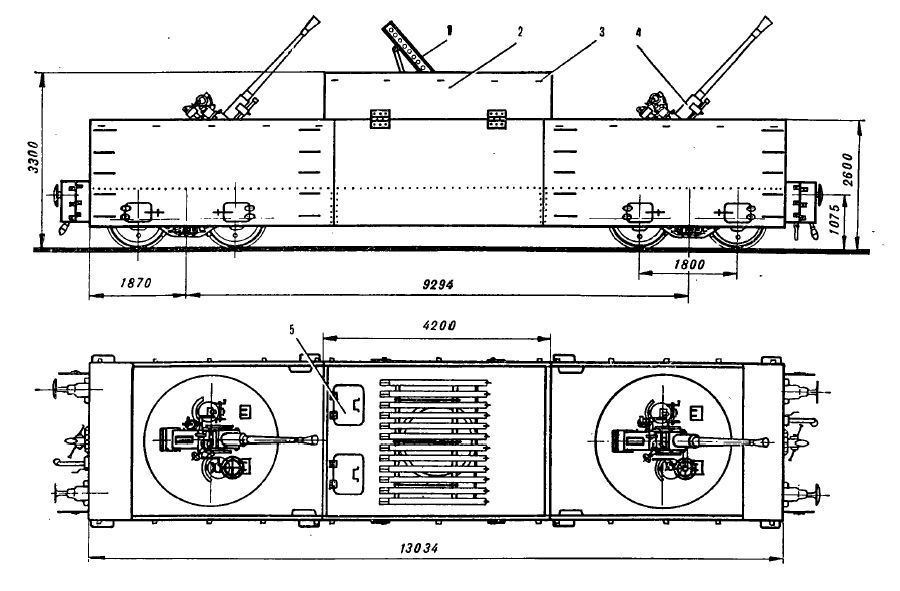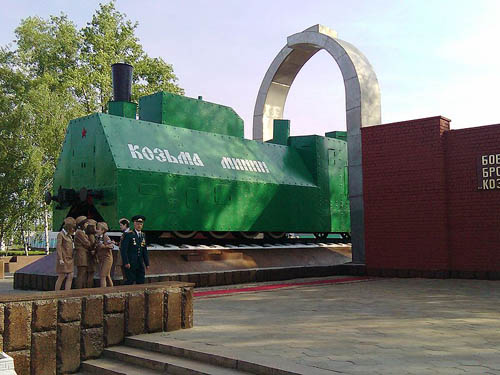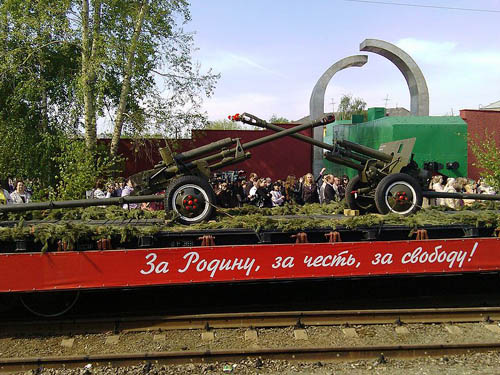Kozma Minin (1942)
 31st Separate Special "Gorky-Warsaw" AT division.
31st Separate Special "Gorky-Warsaw" AT division.BP-659 "Kozma Minin", BP-660 "Ilya Murometz" 1942-45.
The most famous WW2 Soviet Armoured Train ?

Back in 1941 after the German invasion, the need for armoured trains for the Red Army led to design a standard. Probably the most common and powerful was the BP-43 armoured train. It consisted in the PR-43 armoured locomotive in the middle, PL-4 artillery armored railcar on both sides of the armored personnel carrier, two AA armored railcars and two armored personnel carrier with the fire control unit as well as a the OF-4 anti-aircraft guns, and control platforms plus utility cars with spares and supplies. Typically each had a single armoured railway car with a standard T-34/76 tank turret. It was also often accompanied by rail-converted BA-20 armoured cars used for reconnaissance on either end of the line. Later in the war, likely from 1943, these were rail-capable BA-64s.
In all during the war, the Red army maintained some 21 BP-43 type armoured trains and a similar number were operated by the NKVD. Some had heavy artillery carriages armed with a 107 mm howitze with a range of up to 15 km and protected by up to 100 mm armour, immune against 75 mm caliber shell. After being refuelled, the BP-43 was capable of crossing 120 km at 45 kph, the trailer carrying 10 tons of coal or 6 tons of fuel oil for a grand total no superior to 400 t. In other configurations, the BP-43 could comprise a command and control wagon, two armoured platoon carriers (MG armed), two AA cars (one platoon), two T-34 cars, two BA-20 and three BA-30 all railway capable. When tires were mounted they ventured at 10-15 km on either side of the train for reconnaissance.
BP-659 "Kozma Minin"

One of these BMP-43 trains was modified and named "Kozma Minin". It was uilt in February 1942 at the Gorky-Moskovsky carriage depot, under engineer Leonid Dmitrievich Rybenkov. It had an armored locomotove, two armored troop railcars, two open artillery railcars mounting each a single M-8 rocker launcher and two 37 mm AA guns, plus a single 4-axle control platform. But its best assets were the two 4-axles armoured railcars sporting two T-34 tank turrets instead of a single two axle railways/single turret as in most BP-43s. The turret sported a 76 mm gun and 7,62 mm DT coaxial, but the railcars were tall enough for a four 7,62 mm Maxim machine guns placed in ball bearings on either sides. There was even a small control blockhouse in the middle.
The other two open artillery wagons had three compartments with 37-mm anti-aircraft guns in the front and rear compartments, and the M-8 rocker launcher in the center. Whatever the railcar, protection was an uniform 45 mm (2.2 inches) capable of defeating German guns up to 50 mm thanks to the slopes, with an upper and roof armor 20 mm thick (1 inch). The armoured locomotive was protected by plates from 30 to 45 mm in thickness. There was a tender with fuel oil, also armoured and the locomotive had a command post connected to the driver's cabin with an armored passage. There was an intercom running all along the train so that each railcar can communicate with the central at the locomotive.
From his cabin, the commander of the armored train controlled everyone by telephone but for external communication he had a long-range radio RSM emitter/receiver set at his disposal. Kozma Minin had more firepower than a standard BP-43 thanks to its four F76 cannons provided with HE and AP shells. They were tasked of dealing with incoming armour, tanks and lighter reconnaissance vehicles. At aimed fire thanks to the M-8 RL, the train had a range of up to 32 km with its high angle M-12 launcher.
Kozma Minin PL-42 Railcars
There is not much to say about it. It was unpowered (nota draisine) and much taller than an average T-34 tank (almost twice as high) so about 2.47 m tall without turrets, and around 3.20 meters overall. Each railcar was three meters wide and 12.7 meters long. It was composed of three compartments: A central one comprising the central command with four machine gun posts and an elevated platform for a 4-faceted prismatic blockhouse and sight slits on all faces to scan the surroudings. It was not taller than the turrets and so front and vision rear field of vision was reduced.The two other compartments fore and aft were a bit lower. There was a roof step to the middle, with large top access hatches, no side doors, seen as a protection weakness. To access the railwar, personal had to climb a 4 step latter located on either side in the middle section, and the forward and back plate ladders, and enter the hatches or the turrets via their own hatches. The four firing posts presented an armoured opening with a ball mount inside and vision slits.
The main armament was the 76.2 mm F-34 main gun associated with the T-34/76 tank turret. The model was 1942, with a large forward-opening hatch and smaller in-hatch, a TMFD-7 or PT4-7 episcope, two side ports, a back ammunition port, and early type casting. They had each a coaxial DT light machine gun, same type as in the central compartment, with perhaps 6,000 rounds between them. Unlike the tanks, the large compartment could hold more rounds than the 77 allocated to the regular T-34/76 model 1942, perhaps 100 or 150. With APCR it could defeat 92 mm (3.6 in) or armour at 500 m (1,600 ft) and 60 mm (2.4 in) at 1,000 m (3,300 ft).
The crew of each compartment thus comprised three men, the commander, gunner and a loader passing on ammunition from below the pannier. The latter was mounted on a solid structure enchored on the railway car floor. The turrets were facing inward when travelling to avoid the guns protruding. Like most armoured trains of the time the wagon stops on either side were protected under armoured guards.
The cast turret offered a protection ranging from 65 mm (2.56 in) forward down to 20 mm (0.79 in) on the roof. The railcar received a sloped armour, which lower part was dotted with eight access hatches to the bogies for maintenance, and an upper part starting over the railway flatbed, sloped upwards. The access hatches were particularly large and heavy, but one open, could allow fire on the move. The personal armament of the crew, at least six turret crew combined, four MG gunners, four loaders and an officer commander, went to 15 with perhaps a cook/mechanic, and assistant to the telephone. As said above tge PL-42 tank railcars were not powered and could not act independently. They were located either side of the armoured locomotive/trailer, and linked out to the AA/rocket open flatcars.
PL-4 Artillery Railcars

The basic railcar was divided into three compartments, all open. The rear and aft ones had platforms on which wewere mounted standard OF-4 37 mm anti-aicraft guns and the centra compartment, either opened or with optionally folding panels, up or down, housing an M-8-45 rocket launcher. All three had the standard elevation and 360° traverse of their original mount. Reloads for the rocket launcher were located in the compartment below, passed on through hatches. The side armour was 45 mm, front and rear plates were 20 mm as the folding panels. There were no doors and access was only possible by using ladder hanbars on four locations.
The 37 mm or 1.5 in OT-4 or M1939 61-K came with a standard "X" shaped leg platform called the four-wheeled ZU-7 carriage, with folding roadwheels, which were removed. The mount were attached to a bolted ball bearing foot on the platform. The model was long derived from the model 1933 Swedish 25 mm Bofors. The 37 mm M1939 AA gun fired a 37 × 252 mm SR shell weighting 730 g (1.61 lb) Frag-T or 770 g (1.70 lb) AP-T for anti-armour business. The barrel had Hydro-spring recoil, elevates to 85° and had a 160-170 rpm fire rate, and with a muzzle velocity of 880 m/s (2,900 ft/s) it could reach 4 km (13,000 ft) in ceiling and a 5 km (16,000 ft) range max. Against tank with the AP round, it could defeat 37 mm of RHA at 60° at 500 metres range or 28 mm at 90° at 1,500 metres.
The central compartment had a M-8-45 launcher with 12 ramps for twice as much (24) 82 mm rockets (3.2 inch) strapped on top and below the ramps, same model used for the ubiquitous BM-8 Katyusha. They had a range of 6400 meters and were manned by two to four for reloading. It fired as standard an HE warhead but with AP rounds and illumination oens available at the end of the war.
PR-43 Armoured Locomotive
(To come)Combat Use
During the war, Kozma Minin was assigned to the 31 separate separate Gorky division of armored trains. It was in 1945 claimed to have shoot down 14 or 15 aircraft from Commissioner Alexei Potekhin's memoirs. Kozma took part in the defense of Tula, the liberation of Orel, Bryansk, Gomel. Pushing west it took part in the liberation of Wolomin (On 23 February 1943 the inhabitants presented a bronze lion in gratitude), and was present in Prague and Warsaw. The war ended and Kozma Minin career fell short of Berlin, never to enter the city as the Germans blew up the bridge over the Oder. Kozma Minin stopped 50 kilometers short from Berlin. After the surrender of May 1945, Kozma Minin protected the government train with the delegation of the Soviet Union at the Potsdam Conference. Postwar she was preserved to this day (see below).Kozma Minin had a twin sister built at the Murom depot, called "Ilya Muromets" after a famous medieval boyard. It's tally was even more ipmressive, with claims of 7 aircraft, 14 guns and mortar batteries, 36 enemy positions, 875 soldiers and... a German armoured train, which was quite rare. This train was even called "adolf hitler" postwar but this was debunked. This german train was the No. 11 or 22 in June close to the station Kovel, Volyn Oblast, Ukraine. The engagement, quite rare, happened at dawn, and the Russian knew its presence and prepared the attack by night.
The first salvos of rockets obliterated the tracks behind the armored train in order to trap it. The German PC-85 railcar turrets traversed towards Murometz but could only fire HE shells at 5.5 km. They were destroyed by the F-34 cannons, capable of hitting anythin beyond 9-10 km with armor-piercing shells. For 5-6 min. both trains exchanged volleys and hit, while the M-8 rocket launchers were rearmed. When ready they unloaded their payload directly at the train and savaged it in a few seconds. The battle was over. A month later in July 1944, Kovel was freed and Soviet soldiers discovered and examined the destoryed German armored train, confirming the 400t "kill". This is probably the only armored train duel in WW2.
Legacy

The modern Kozma Minin (2010-2020)
The name was so famous in USSR that it was revived by the Russian MoD ro control "banditry" in the north caucasus in 2010. Unlike the original Kozma Minin the new one is not a battleship on rails, but rather a "battle cruiser", well protected yet highly mobile. Its armament is intended for a defensive role and capability to lead mine-clearing operations, line maintenance and other defensive operations.
The new Kozma Minin was built by a Volga-Vyatka OMON unit in 1994, from old railway platforms and ties, scrap metal and other materials at hand, with the covered wagon painted in a brown with a green camouflage pattern and the rest with well-worn camouflage netting. It was deployed in the North Caucasus until retired to a rail-yard in 2002. Several cars sported “OMOH” for "Otryad Mobilniy Osobogo Naznacheniya" (Special Purpose Mobile Unit) as per interior ministry units. it had the Kamysh (Cane) anti-mine M4K system (2009) using white noise to interfere with radio-controlled explosive devices from 20 meters away. Protection was made mostly of sand-bags and timbers with scrap metal plates.
It was armed with two quad-barrel ZPU-4 AA guns, ten AGS-17 automatic grenade launchers and machine-guns. On ftalcar carried a resident BMP-2 IVF protected by sand-bags and brining the firepower of its 30-mm 2A42 autocannon, 9P135M anti-tank guided-missile launcher and 7.62-mm coaxial machine gun. In some photos it showed up to two T-62 tanks. It operated at Mozdok, North Ossetia and Khankala a rail station, east of Grozny, Chechnya. In Khankala it operated with the 42nd Motorized Rifle Division. Its overhaul was completed on December 1, 2013 at 635,000 roubles.

The original Kozma Minin was not preserved but a replica is now located in the great patriotic war Nizjni Novgorod museum. It is placed on tracks inside a sculpture and attacts many visitors as all cars can be visited.
Gallery

T-34 combat cars

AA and Rocket Car, panel closed

37mm AA and Rocket Car, panels open
Locomotive and trailer (To come)
The full train with end trailers (To come)

tracesofwar.com

tracesofwar.com
papermodel.com
Sources
Tanki Vtoroy mirovoy voiny" (Album) Moscow, Technika-Molodezhi,2000Modelist-Konstruktor, 9/98
Voyennaya Letopis/Military Chronicle, Bronetankovyi Muzei No. 3, Moscow, 2002
On armchairgeneral.com
On en.topwar.ru
Armoured loco on scalemates
- Baldwin Railroad battery 1861
- No 6 Garrison Arm. Train 1894
- Ladysmith Train 1899
- Crewe Works 1915 coastal train
- French mobile artillery battery (1914)
- Royal Navy armoured Train 1914
- Regia Marina Arm. Trains 1915-18
- Ajmer arm. trains 1916
- Hungarian MAVAG train
- German Panzerzug Ost (1916)
- Bolshevik Armored Tram 1917
- Finnish Arm. Train (1918)
- Zaamurets (Orlík, BP-4, Lenin)
- Khunkhuz
- General Annenkov
- Yenisei
- Amur
- Terek
- Don
- Dywizja Syberyjska trains 1918
- Kozak
- Piłsudczyk
- PP3
- Gromobój
- Pionier
- Śmiały
- Lis-Kula
- Hallerczyk
- Stefan Batory
- Generał Iwaszkiewicz
- Chrobry
- Wilk
- Danuta
- Poznańczyk
- Kaniów
- Zawisza Czarny
- Zagończyk
- Paderewski
- Mściciel
- Reduta Ordona
- Huragan
- Podhalanin
- Bartosz Głowacki
- Pierwszy Marszałek
- Groźny
- Śmierć
- Śmigły
- Stefan Czarniecki
- Generał Sosnkowski
- Putilov armoured trains
- Izhorskiy Armored Train
- Czechoslovak Legion Trains
- Estonian Trains
- Lithuanian Trains
- Zhang Zongchang Train
- Danuta
- Poznańczyk
- Generał Sosnkowski
- Paderewski
- Śmierć
- Pierwszy Marszałek
- Piłsudczyk
- Śmiały
- Groźny
- Bartosz Głowacki
- Smok Kaszubski
- Drezyna R
- Drezyna TK/TKS
- UK dywizjon Trains
- SOK Draisines 1945
- Arm. draisine Crochat
- Austro-Daimler Draisine
- Armoured draisine Tatra T18
- MBV-2 Rail cruiser
- D-2 Draisine (MBV-31)
- D-37 Draisines
- Krasnaja Zvezda (KZ-1)
- D-3 Draisines
- BTD heavy Draisines (5)
- CB-1 Draisines
- DT-45 Draisines
- BD-41 Draisines (12)
- BA-I-Zhd Railcar
- BA-6ZhD Railcar
- BA-20ZhD Railcar
- BA-10Zhd Railcar
- VS-60 Train/Wagon
- BP-35L/H Train
- NKPS-42/Wagon Train (40)
- PL-35 Arty Wagon
- PL-37 Arty Wagon
- PT-35 Arty Wagon
- KV-1 Arty Wagon
- Crimean 76mm univ. Wagon
- "Tank" Wagon
- BP-42 Train/PL-42 Wagon (10)
- BP-43 Train/Wagon (54)
- 7.62mm Maxim SPU-BP Flak wagon (28)
- 37mm PVO-4 FLAK Wagon (120)
- OB-3 Light Wagon
- 27th Div armoured Trains
- 29th Div armoured Trains
- 48th Arm. Div armoured Trains
- "Stalinets" armoured Train
- "Mir Jafar Bagirov" armoured Train
- "Kozma Minin" armoured Train
- "Dzerzhinets" armoured Train
- "Za Rodinu!" armoured Train
- "Kolomensky Rabochy" armoured Train
- Zenitnyy (AA) armoured Trains
- Goering's Asien
- BP42 armoured train (full)
- BP44 armoured train (full)
- Panzerjägerwagen BP44
- BR 52, Steyr Schwerer Schienen Panzer
- Schwerer gustav Train
- P204(f) rail tank
- Schienenkampfwagen SK 1
- Schwerer Spähzug (s.Sp.) Artilleriewagen
- LeichteSchienenkampfwagen 43
- Zeppelin Panzer Draisine
- Panzertriebwagen N17
- Panzertriebwagen N16
- Panzer Draisine Funkwagen
- Panzerdraisine/Pz.III turm
- Panzerdraisine/Pz.IV turm
- Panzer Draisine Le.Sp.
- Panzer Draisine Flakvierling
- S.Panzer Draisine Kugelblitz
- L2670 leichtes panzertriebwagen
- AB Ferroviana
- Littorina OM 36
- LiBli 42
- Type K2 Steam Locomotive No.134
- Type C56 Steam Locomotive No.31
- Type 90 240 mm Railway Cannon (Futtsu Cannon)
- Type 91 Broad-gauge Railroad Tractor (So-Mo)
- Type 94 Armoured Train
- Type 95 Armoured Railroad Car (So-Ki)
- Type 98 Railroad Tractor
- Type 100 Railroad Tractor
- Type 2598 Railroad Car
- Rinji Soko Ressha 1933
- 1940 coastal defence Trains
- Royal Armoured Corps Trains
- Romney, Hythe and Dymchurch Train
- Malaya Arm. train 1942
- 101-104. sz. páncélvonat
- Finnish Winter War Train
- Croatian Armored Train
- Can. Aleutian No.1 Armoured Train
- Slovak resistance armoured train
- Iraqi armoured train (1941)
- Polish 1945-55 trains
- Arm. train La Rafale 1948
- Tren Blindado 1958
- Panser Rel V16 (1955)
- White Train 1957-87
- RT-23 Molodets ballistic wagon
- Trans-Siberian Arm. Train 1970
- North Korean Arm. Train
- Krajina express 1990
- Volga (2022)
- Baikal (2022)
19th Cent. Trains
WW1 Armored Trains
 Poland
Poland
Interwar Armored Trains
WW2 Armored Trains
 France
France
 Austria
Austria
 Czechoslovakia
Czechoslovakia
 USSR
USSR
 Nazi Germany
Nazi Germany
 Italy
Italy
 IJA
IJA
 UK
UK
 Others
Others
☢ Cold war Armored Trains
References
blog.railwaymuseum.org.ukarmedconflicts.com Russian Trains
warhistoryonline.com
feldgrau.com ww2 german trains
cuttersguide.com
wikipedia.org/wiki/Armoured_trains_of_Poland
derela.pl/drais
derela.pl/tatra.htm